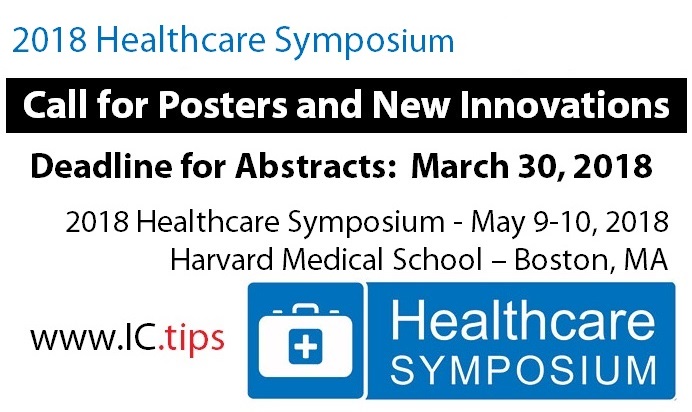Abstract
The Healthcare symposium takes a multi-faceted approach to improving patient outcomes through hospital design and management by bringing together clinicians, engineers, and architects. On May 9-10, 2018, national and global leaders will meet at Harvard Medical School in Boston, MA. to discuss innovations and considerations in hospital environmental design. For more information and registration, please visit: http://healthcaresymposium.org/registration/
Main Article
The idea of using patient clinical outcome data to guide hospital design and management is a new concept which requires understanding and integrating user workflows with indoor air management to create an environment that will reduce the spread of infectious diseases. Traditionally, environmental design was strictly the territory of architects and engineers, who understand what is needed for a functional hospital and who typically focus on the costs of design elements.
However, the costs associated with pathogen transmission and hospital associated infections can be astronomical. Saving on costs for efficient designs can be short-sighted if unintended consequences such as complicated workflows and changes in the indoor environment which increase the potential for hospital associated infections are not considered (Lankford et al, 2003, de Korne et al, 2011). Clearly, there are multiple aspects to design.
As previously discussed, clinician workflow is incredibly important. Requiring employees to transfer potentially contaminated containers across hospital rooms, or whole wings is not necessarily harmful, but each step, touch of a door handle, or change in air flow increases the chance of a infectious microbe being transmitted through the built environment (de Korne et al, 2011). Most designers are aware of appropriate surface selection in hospitals. This can include choosing non-porous surfaces in high touch areas and being very selective about the type of textiles that are used for soft surfaces. While these decisions are important, a reduction in the number of times the surfaces need to be touched also reduces transmission. Another unseen vector for contamination is indoor air. Obstructed or inappropriate airflow can initiate a chain of events that liberates particles and pathogens which then spread in the indoor environment (Liu, Wang and Wen, 2009). Room humidity also plays a role in infection control, as many harmful microorganisms settle out of the air and have shorter survival times in properly humidified environments.
The 2018 Healthcare Symposium (http://healthcaresymposium.org/) will bring together specialists to discuss these topics in much more detail. Among these topics are:
- The use of balanced humidification to ensure optimum patient healing
- Surface disinfection strategies
- Airborne infectious disease management
- Energy and operational cost reduction
- Indoor air hydration for control of infectious disease transmission
- How to improving staff health and productivity, and reduce absenteeism through indoor air management
Featured at the conference reception will be Dr. Jeffrey E. Thompson, MD, who is the executive advisor and chief executive officer emeritus at Gundersen Health System. Gundersen Health System has been recognized across the country by independent healthcare ratings organizations for high-quality patient care. It has also earned the highest honors of Healthgrades America’s 50 Best Award for 2012 through 2016 and the White House Champions of Change award in 2013. Additionally, the co-founder of InfectionControl.tips, Michael Diamond will be discussing the impact of international collaboration on patient safety.
Call for Posters and New Innovations
Attendees are encouraged to present their new innovations and data to the conference audience of key leaders in hospital safety. The deadline for abstract submissions is March 30, 2018. Please submit all abstracts to [email protected]. Please ensure that abstracts adhere to the following guidelines
- Abstracts must be within the realm of building design and management to improve health, including, but not limited to: surface selection and disinfection, healthcare and public building design, transmission of infectious diseases, building resource utilization in healthcare, health promotion, patient and employee safety, and monitoring and control of infectious disease transmission.
- Abstracts should be 400 words or less, and structured to include a purpose/hypothesis, methods, results, and significance section.
- Include a title page that indicates the abstract title, all authors, their affiliations and degrees. Please include the contact information for one corresponding author. This is not included in the word count. Please disclose all potential commercial conflicts of interest for each author.
- Abstracts and their content cannot be previously published.
- Changes to abstracts will not be accepted after March 30, 2018.
References
de Korne, D. F., van Wijngaarden, J. D., van Rooij, J., Wauben, L. S., Hiddema, U. F., & Klazinga, N. S. (2011). Safety by design: effects of operating room floor marking on the position of surgical devices to promote clean air flow compliance and minimise infection risks. Quality and Safety in Health Care, qhc-2011.
Lankford, M. G., Zembower, T. R., Trick, W. E., Hacek, D. M., Noskin, G. A., & Peterson, L. R. (2003). Influence of role models and hospital design on the hand hygiene of health-care workers. Emerging infectious diseases, 9(2), 217.
Liu, J., Wang, H., & Wen, W. (2009). Numerical simulation on a horizontal airflow for airborne particles control in hospital operating room. Building and Environment, 44(11), 2284-2289.
REVISED: February 22, 2018












